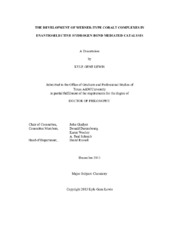| dc.description.abstract | Chiral-at-metal Werner complexes of the type (Λ/∆)-[Co(1,2-diamine)_(3)]^(3+) 3X^(–)have long been a cornerstone of coordination chemistry. However, despite being inexpensive and readily available in enantiopure form, they have had no applications in enantioselective organic synthesis. This derives from their poor solubility in organic solvents and the fact that the chelating ligands are non-labile, preventing metal based substrate activation. However, it was conceived that the abundant nitrogen-hydrogen bonds of the diamine ligands could activate Lewis basic substrates towards nucleophilic addition via hydrogen bonding.
Towards this end, the diastereomeric trications Λ-[Co((S,S)-dpen)_(3)]^(3+) and ∆-[Co((S,S)-dpen)_(3)]^(3+) (dpen = diphenyl ethylenediamine) were prepared by stereoselective syntheses. Incorporation of the lipophilic Bar_(f)^(–) (B(3,5-CF_(3)-C_(6)H_(3))_(4)^(–)) anion, among others, afforded the organic-soluble mixed salts Λ-[Co((S,S)-dpen)_(3)]^(3+) 2X^(–) BAr_(f)^(-) and ∆-[Co((S,S)-dpen)_(3)]^(3+) 2X^(–) Bar^( –)(X = Cl^(–), BF_(4)^(–), PF_(6)^(–)). These Werner complexes were then applied as hydrogen bond mediating catalysts for enantioselective Michael additions of dialkyl malonates to nitroolefins.
The catalyzed Michael addition of dimethyl malonate (15a) to trans-β- nitrostyrene was optimized with respect to solvent, temperature, and catalyst counteranion and then extended to a range of nitroolefin substrates. Under optimized – conditions, Λ-(S,S)-3^(3+) 2BF_(4)^(–) Bar_(f)^(-) (10 mol%) catalyzes the Michael addition of 15a to 2-benzyloxy-trans-β-nitrostyrene in acetone at 0 °C in the presence of Et_(3)N (1.0 equiv) to afford dimethyl 2-(2-nitro-1-(2 benzyloxyphenyl)ethyl)malonate in 95% isolated yield and 96% ee.
This work marks the first time that a Werner-type complex has been applied as a catalyst for organic transformations with high enantioselectivities. The unique stereochemistry of the Werner complex, which features a chiral metal center, is primarily responsible for the stereoselectivity of the catalyzed reactions. | en |


